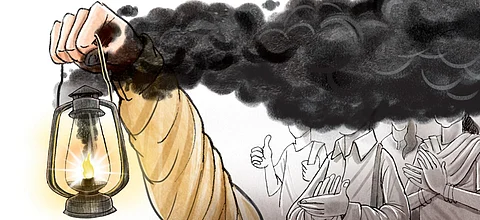

In a recent speech at the European Parliament, German Chancellor Angela Merkel made a forceful case against rising disinformation and the populism that stokes it. Speaking in the context of the Covid-19 crisis, Merkel asserted, “We have seen lies and disinformation, and that is no way to fight the pandemic,” and that “the limits of populism and denial of basic truths are being laid bare”. Merkel was giving voice to the frustration of many against populism, fact denialism and propagandist politics channelled through charismatic strongmen around the world.
As Merkel suggests, real world problems are not amenable to populist solutions. India is no stranger to this phenomenon. It is paying a price for employing simplistic solutions to complex problems, for elevating disinformation over informed discourse, and for creating myths to bury reality. In my last column for this newspaper, I spoke of a confluence of three crises buffeting India—a health crisis, an economic crisis and a national security crisis. In proposing ideas for tackling these inter-linked crises, I missed an opportunity to highlight a very important ingredient—truth-telling.
Obfuscation, and we see a lot of it these days, will hurt India’s ability to deal with these crises. The problem with denying the truth and actively propagating falsehoods is that it leads to the creation of myths, which could loop back into policymaking. This is dangerous and can have serious consequences.
In this context, three examples of obfuscation and one instance of myth-making come to mind. On the Covid-19 pandemic, Prime Minister Narendra Modi misled the public into believing that a 21-day lockdown would “break the chain” and contain the virus. There was no scientific evidence backing such an assertion but this would not be the first time he enacted evidence-free policy.
With over a million confirmed Covid-19 cases, a rapidly rising caseload and a shambolic health system, one can only hope for the best. After all, we simply have not prepared for the worst. Commerce Minister Piyush Goyal provides the second prominent example of obfuscation. After news broke of India generating a trade surplus last June, Mr Goyal tweeted the following: “Rapid Turnaround of Exports: Realising PM @NarendraModi ji’s vision of Atmanirbhar Bharat, for the first time in 18 years, India records a monthly goods trade surplus in June!” Ordinarily, the first monthly trade surplus in 18 years should indeed be cause for celebration.
The BJP’s IT cell is probably bombarding this message to millions of WhatsApp accounts. However, what Mr Goyal may not wish to tell people is that India’s exports contracted 12.4% while imports declined 47.6% in June. In fact, what the senior minister is celebrating is a devastating demand slowdown both in India and abroad. Is the government clueless or is it counting on our ignorance?
The third example of obfuscation leads us to Mr Modi again. In the standoff with China, the prime minister categorically stated, “Nobody has intruded into our border, neither is anybody there now, nor have our posts been captured.” Since that time, it is amply clear that not only was Mr Modi misleading the country, he ended up gifting propaganda talking points to the Chinese.
Some analysts believe that he was being pragmatic given the disparity between the Indian and Chinese militaries and that his ban on some Chinese apps, dubbed a “digital strike” by a fawning mainstream media, was a way to not lose face and score political points domestically. Is this sound national security policy? Such government obfuscation serves India poorly. More problematically, it eventually takes on mythic proportions and could possibly infect policymaking. One such myth is about the economic development gap between India and China. Some analysts argue that India is about 10-15 years behind China. The logic is that the Chinese started economic reforms in 1978 and India in 1991.
That 13-year gap sustains. As evidence, some point out that India’s GDP per capita in 2019 is the same as it was for China in 2006. If India grows faster, this gap will narrow. This 13-year gap is a myth. It is only one part of a much bigger story. China is much further along on the development frontier. India’s literacy rate in 2018 was close to China’s rate in 1990. Stunting in Indian children today is close to China’s level in the early 1990s.
Poverty ($1.90/day) is almost non-existent in China. In agriculture, manufacturing, trade, infrastructure investment and on so many other indicators, China is a true global giant. That means it has also built extensive trade linkages across the globe. And if anyone tells you that the future belongs to India, keep in mind that China filed more applications (58,990) under the Patent Cooperation Treaty than any other country in 2019. India filed only 2,053 applications. Innovation is key to the future. China is far ahead.
Members of India’s ruling establishment face a stark choice.
They could accept reality and develop a coherent and implementable long-term development strategy to compete with China. The other option is to keep denying facts, cover up failures and hope that keeping the public in the dark will create enduring political power. The cost of this second option will be enduring underperformance and a diminished role for India in global affairs. Who is ready for that trade-off?
Salman Anees Soz
Deputy Chairperson of the professionals’ wing of the Congress
(The author was formerly with the World Bank. Views are personal. Tweets @SalmanSoz)